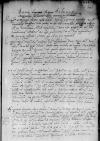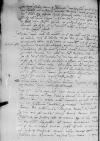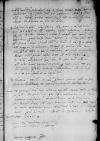Post eas, quas mense precedenti Tuae
S(trenuita)ti or S(incerita)ti⌈S(trenuita)tiS(trenuita)ti or S(incerita)ti⌉
dupplicatas scripsimus litteras, quibus ea, quae tunc occurrebant, non visis adhuc litteris per Pantaleonem allatis scripseramus. Nunc autem, quamquam per eas litteras Pantaleonianas recent written over s⌈stt written over s⌉iores Tuae
S(trenuita)tis or S(incerita)tis⌈S(trenuita)tisS(trenuita)tis or S(incerita)tis⌉
habuerimus et eis iam respondimus. Et his quoque respondere placuit quo ad ea, quae important.
Legimus integras omnes illas prolixas litteras alphabeticas
s(acrae) or s(erenissimae)⌈s(acrae)s(acrae) or s(erenissimae)⌉
⌊regiae maiestati⌋ transmissas et multum legisse placuit, omnia enim, ut aiunt, ad unguem, et ex amussim ms. anusim(!)
⌈amussimamussim ms. anusim(!)
⌉ perscripsit, ex quibus cognovimus suam optimam dexteritatem et incomparabilem in his rebus rebu regiis et nostris diligentiam, quam non nisi summa gratitudine ac gratia nostra rependere debebimus. Nec plus promittere sufficimus, quam facere cogitemus. Hocque sibi confidenter persuadeat
S(trenui)tas or S(inceri)tas⌈S(trenui)tasS(trenui)tas or S(inceri)tas⌉ Tua.
Quoad ⌊castellum Barense⌋ et ⌊castellanum⌋ eius, postquam ita iam ⌊caesareae maiestati⌋ placuit, ut iste castellanus remaneat, donec cognoscatur etc., et nobis contravenire non licet. Verum tamen, ut interesse praetendentibus terminus praefigatur, quoadusque haec quaestio in suspensio durabit, ut sic non pendeat perpetuo et ubi decidenda foret etc., prout alias scripsimus, iam nos dedimus mandatum in ⌊Barum⌋ ad ⌊thesaurarium nostrum⌋, ut recipiat iuramentum nostro nomine a castellano moderno vel eius locum tenente super fidelitate et homagio secundum primum mandatum et decretum sacrae ⌊caesareae maiestatis⌋. Itaque speramus facturum castellanum seu locum tenentem, si aliud interea contrarii ibidem non acciderit, quod Tua
S(trenui)tas or S(inceri)tas⌈S(trenui)tasS(trenui)tas or S(inceri)tas⌉
ibidem diligenter curare debuit.
Cu written over De⌈De Cu Cu written over De⌉m legatariis concordiam facere commissimus, nolentes nos subicere tot incertis litibus et coram suspectis iudicibus et, secundum quod cum eis concordatum fuerit, singulis de proventibus nostris satisfieri mandavimus, salva tamen protestatione circa[1] solutionem eis fienda (istam condicionem, si possemus, addemus) on the margin⌈(istam condicionem, si possemus, addemus)(istam condicionem, si possemus, addemus) on the margin⌉[2]; quod nos haec fecimus. Si et quatenus de iure teneremur, alioquin sumus in animo et proposito repetendi ab eis iniuste et indebite persoluta loco et tempore opportunis. Et ita de his iam non curet
S(trenui)tas or S(inceri)tas⌈S(trenui)tasS(trenui)tas or S(inceri)tas⌉
Tua nec sollicitet, extremam manum illis imponere iussimus. Quamquam et pro ratione, et pro aequitate stantibus capitulis nostris confirmatis nil solvere teneremur,  BCz, 1601, p. 604 hoc tantum curabit, donec ibi
ill(ustrissimu)s or ill(ustri)s⌈ill(ustrissimu)sill(ustrissimu)s or ill(ustri)s⌉ ⌊vicerex⌋ fuerit, ut de illis, quae sunt iam conclusa, nil in contrarium innovetur. Et interea terminus peremptorius et locus decidendae super possessione castelli controversiae ultimus et finalis determi(netu)r. Illudque nobis summe placuit, quod Tua
S(trenui)tas or S(inceri)tas⌈S(trenui)tasS(trenui)tas or S(inceri)tas⌉
prius sacrae ⌊caesareae maiestati⌋ et deinde an(t)ea or an(te) ea⌈an(t)eaan(t)ea or an(te) ea⌉ ⌊cancellario⌋ dixerat, ut quidquid super isto statu facere decreverint, certo faciant et nos manibus, verbis et promissis non alant, nec tot expensis afficiant.
BCz, 1601, p. 604 hoc tantum curabit, donec ibi
ill(ustrissimu)s or ill(ustri)s⌈ill(ustrissimu)sill(ustrissimu)s or ill(ustri)s⌉ ⌊vicerex⌋ fuerit, ut de illis, quae sunt iam conclusa, nil in contrarium innovetur. Et interea terminus peremptorius et locus decidendae super possessione castelli controversiae ultimus et finalis determi(netu)r. Illudque nobis summe placuit, quod Tua
S(trenui)tas or S(inceri)tas⌈S(trenui)tasS(trenui)tas or S(inceri)tas⌉
prius sacrae ⌊caesareae maiestati⌋ et deinde an(t)ea or an(te) ea⌈an(t)eaan(t)ea or an(te) ea⌉ ⌊cancellario⌋ dixerat, ut quidquid super isto statu facere decreverint, certo faciant et nos manibus, verbis et promissis non alant, nec tot expensis afficiant.
Intelleximus optime omnia illa impedimenta, quae
s(erenissimae) or s(acrae)⌈s(erenissimae)s(erenissimae) or s(acrae)⌉
⌊regiae maiestati⌋ nobis quoque adversarii nostri obiciunt, primum de luterismo et cum ⌊duce Prussiae⌋ connubiis etc., ac Thurcano foedere, et quam optime ac rationabiliter, iuste quoque et debite nos et suam maiestatem on the margin⌈et ⌊suam maiestatem⌋et suam maiestatem on the margin⌉ excusaverit, et multum hoc intellexisse profuit, quod autem nunc praesumitur, quod maiestas sua cum his ducibus Germaniae aliquas condiciones coeperit nec hic umquam somniatum fuit, quod Tua
S(trenui)tas or S(inceri)tas⌈S(trenui)tasS(trenui)tas or S(inceri)tas⌉
confidenter dicere
potit(ur) or pot(uer)it⌈potit(ur)potit(ur) or pot(uer)it⌉. Ita ergo ob eas falsas suspiciones nos vera iura nostra amittere debeamus? Et ob hoc, quod ille dominus ⌊vicerex⌋ sic ambit et aspirat ad hunc ⌊statum nostrum⌋, istae suspiciones debeant valere? Sicut et contra famulos tuos processum fuit, et contra nos procedere vellent? Quod autem dux Mediolani cesserit iuribus suis, et nescitur in cuius favorem, hoc subaudiat diligentius
S(trenui)tas or S(inceri)tas⌈S(trenui)tasS(trenui)tas or S(inceri)tas⌉
tua, quorsum haec evadent et quid futurum speratur.
De relevio caesareo, iam illud exsolvere commiseramus et exsolutum esse scimus in next line in place of crossed-out credimus⌈credimus scimus scimus in next line in place of crossed-out credimus⌉ ex proventibus nostris pendente sequestro retentis.
Accepimus ex litteris
s(acrae) or s(erenissimae)⌈s(acrae)s(acrae) or s(erenissimae)⌉
⌊regiae maiestati⌋ scriptis damna et incommoda Tuae
S(trenuita)tis or S(incerita)tis⌈S(trenuita)tisS(trenuita)tis or S(incerita)tis⌉
cum sua indignitate ac etiam levitate in detinendis famulis ac amittendis nonnullis rebus suis perpessa, quibus compatimur ex animo. Et licet nos illi commiseramus iamdudum per mercatores ⌊Velserorum⌋ aut ⌊Focarorum⌋ dari singulis mensibus octoginta ducatos et aliquando pro tribus aut quattuor mensibus, simul servato computo praedicto,
creden(tes) or creden(do)⌈creden(tes)creden(tes) or creden(do)⌉ eidem hoc sufficere posse et
recordan(tes) or recordan(do)⌈recordan(tes)recordan(tes) or recordan(do)⌉, quod orator olim ⌊matris nostrae⌋, dum similiter ibidem agebat, LX-ta ducatis contentabatur. Verum tamen nunc pro rerum et temporum qualitate iussimus iam nunc et scribimus ad ⌊Ioannem Iacobum de Dunignano⌋, mercatorem nostrum ⌊Venetiis⌋ agentem, ut conveniat cum mercatoribus ⌊Velseris⌋ aut ⌊Focaris⌋, quo Tuae
S(trenuita)ti or S(incerita)ti⌈S(trenuita)tiS(trenuita)ti or S(incerita)ti⌉
 BCz, 1601, p. 605 singulis mensibus respondeatur ibidem de centum ducatis, et nos his satisfaciemus et cedulas Tuae
S(trenuita)tis or S(incerita)tis⌈S(trenuita)tisS(trenuita)tis or S(incerita)tis⌉
redimemus, modo nullum taedium aut fastidium habeat, donec aliquem finem in rebus nostris obtineat et sollicitare, ut solet, non desinat.
BCz, 1601, p. 605 singulis mensibus respondeatur ibidem de centum ducatis, et nos his satisfaciemus et cedulas Tuae
S(trenuita)tis or S(incerita)tis⌈S(trenuita)tisS(trenuita)tis or S(incerita)tis⌉
redimemus, modo nullum taedium aut fastidium habeat, donec aliquem finem in rebus nostris obtineat et sollicitare, ut solet, non desinat.
De sabellinis, de quibus nobis scribit nondum pervenisse eas ad manus suas, sed postquam venerint, exspectare nostram informationem, attento, quod illi(!), cui dari debebantur, reddit se indignum his, postquam non satisfacit promissis suis, nos sumus contentae, quod eos Tua
S(trenuit)as or S(inceri)()tas⌈S(trenuit)asS(trenuit)as or S(inceri)()tas⌉
apud se retineat, donec aliquid certum et firmum de ⌊castro⌋ et ⌊statu nostro⌋ acceperit et obtinuerit. Et tunc, si videbit illum virum rebus nostris superinscribed in place of crossed-out se⌈se nostris nostris superinscribed in place of crossed-out se⌉ non defore et ita se accomodare, uti licuit et promisit, faciet etiam promissis nostris satis. Si autem ⌊caesar⌋ ibit in ⌊Italiam⌋, eum sequatur
S(trenui)tas or S(inceri)tas⌈S(trenui)tasS(trenui)tas or S(inceri)tas⌉ Tua et hos secum afferat. Nos postea secundum negotiorum exigentiam per nostrum nuntium, info quem ad visitandum ⌊caesarem⌋ mittemus, informabimus illum de his et aliis, quae successerint in negotio nostro.
De novitatibus ⌊regiae maiestati⌋ et nobis perscriptis habemus gratias et sumus gratae ac contentae, quod sic accurate et diligenter scribere solet.
1526-04-05⌊Hac die1526-04-05⌋ accepimus suas ⌊⌋ nobis et ⌊regiae maiestati⌋ scriptas ⌊Toleti⌋ ad ⌊Fagum(!)⌋ 1526-01-10⌊X Ianuarii1526-01-10⌋. Ex quibus eadem, quae supra intelleximus, et nova recentiora cognovimus de pace futura et de sponsalibus. Sic faciat semper
S(trenui)tas or S(inceri)tas⌈S(trenui)tasS(trenui)tas or S(inceri)tas⌉ Tua, donec ibi fuerit, et ilustr(?) regiam ac nostram conservabit gratiam optimis suis officiis et obsequiis partam.
Quae bene valeat.
 BCz, 1601, p. 604 hoc tantum curabit, donec ibi
ill(ustrissimu)s or ill(ustri)s⌈ill(ustrissimu)sill(ustrissimu)s or ill(ustri)s⌉
BCz, 1601, p. 604 hoc tantum curabit, donec ibi
ill(ustrissimu)s or ill(ustri)s⌈ill(ustrissimu)sill(ustrissimu)s or ill(ustri)s⌉  BCz, 1601, p. 605 singulis mensibus respondeatur ibidem de centum ducatis, et nos his satisfaciemus et cedulas Tuae
S(trenuita)tis or S(incerita)tis⌈S(trenuita)tisS(trenuita)tis or S(incerita)tis⌉
redimemus, modo nullum taedium aut fastidium habeat, donec aliquem finem in rebus nostris obtineat et sollicitare, ut solet, non desinat.
BCz, 1601, p. 605 singulis mensibus respondeatur ibidem de centum ducatis, et nos his satisfaciemus et cedulas Tuae
S(trenuita)tis or S(incerita)tis⌈S(trenuita)tisS(trenuita)tis or S(incerita)tis⌉
redimemus, modo nullum taedium aut fastidium habeat, donec aliquem finem in rebus nostris obtineat et sollicitare, ut solet, non desinat.



